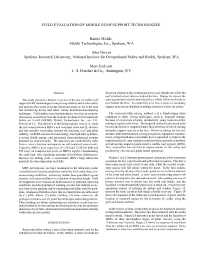Mining Publication: Field Evaluation of Mobile Roof Support Technologies
Original creation date: August 2001
This study presents a historic overview of the role of mobile roof support (MRS) technologies in improving stability and worker safety and presents the results of recent field evaluations of the MRS load rate monitoring device and other remote deformation-monitoring techniques. Field studies were implemented at two sites in cooperation among researchers from the National Institute for Occupational Safety and Health (NIOSH), Maleki Technologies, Inc., and J. H. Fletcher & Co. The objectives of the field programs were to (1) study the interaction between MRS's and coal mine strata and (2) develop and test suitable monitoring systems for assessing roof and pillar stability. An MRS consists of a roof canopy, four hydraulic cylinders, a caving shield canopy, and associated electromechanical systems mounted on crawler tracks. The machines are controlled by radio from a remote location and operate on self-contained power units. Typically, MRS's have capacities of 5,340 and 7,120 kN (600 and 800 tons). In comparison to posts, an MRS is capable of maintaining the yield load after significant amounts of roof-floor deformation. Because the mining cycle is accelerated, MRS's help reduce the potential for time-dependent roof falls. MRS performance has been monitored in the laboratory under controlled static loading conditions and in the field under deep, two seam mining conditions. Laboratory studies have quantified support capacity and system stiffness as a function of machine height. Field investigations have focused on determination of optimum operating conditions and development of warning systems that indicate excessive load on the machine and/or impending roof-pillar stability problems. Analyses of field data show that roof instabilities are influenced by (1) pillar failure, (2) pillar yielding, (3) mine seismicity, (4) geologic structures, and (5) panel layout designs and mining practice. Pillar yielding and failure (unloading) and seismicity can be conveniently monitored by the load rate monitoring device, but for consistent detection of roof falls, additional deformation measurements directly within the cuts are needed.
Authors: H Maleki, JK Owens, M Endicott
Conference Paper - August 2001
Proceedings of the 20th International Conference on Ground Control in Mining, Syd S. Peng, Christopher Mark, and A. Wahab Khair, eds (Morgantown WV, Aug. 7-9, 2001). WV University, Morgantown, WV, 2001; :67-77
See Also
- Analysis of the Interaction Between Mobile Roof Supports and Mine Strata
- Development and Application of the Coal Mine Roof Rating (CMRR)
- Diagnosing and Controlling Moisture-Sensitive Roof in Coal Mines
- The Introduction of Roof Bolting to U.S. Underground Coal Mines (1948-1960): A Cautionary Tale
- Mistakes, Misconceptions, and Key Points Regarding Secondary Roof Support Systems
- Optimizing Secondary Roof Support with the NIOSH Support Technology Optimization Program (STOP)
- Overview of Coal Mine Ground Control Issues in the Illinois Basin
- Performance Characteristics for Welded Wire Screen Used for Surface Control in Underground Coal Mines
- Preventing Falls of Ground in Coal Mines With Exceptionally Low-Strength Roof: Two Case Studies
- Preventing Injuries Caused by Unrecognized Stone Mine Roof Beam Failures With a Pro-Active Roof Control Plan
- Page last reviewed: 6/4/2015
- Page last updated: 6/4/2015
- Content source: National Institute for Occupational Safety and Health, Mining Program


 ShareCompartir
ShareCompartir
